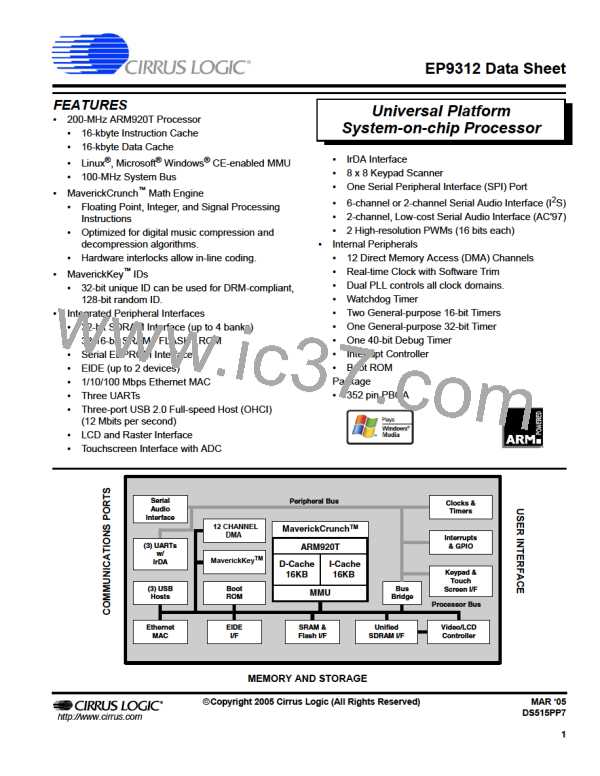EP9312
Universal Platform SOC Processor
receive and a 16 byte FIFO for transmit. Interrupts are
generated on Rx, Tx and modem status change.
•
•
•
•
Fetches endpoint descriptors and transfer descriptors
Accesses endpoint data from system memory
Accesses the HC communication area
•
•
UART2 contains an IrDA encoder operating at either
the slow (up to 115 Kbps), medium (0.576 or 1.152
Mbps), or fast (4 Mbps) IR data rates. It also has a 16
byte FIFO for receive and a 16 byte FIFO for transmit.
Writes status and retire transfer descriptor
Table J. Triple Port USB Host Pin Assignments
UART3 supports HDLC and includes a 16 byte FIFO
for receive and a 16 byte FIFO for transmit. Interrupts
are generated on Rx and Tx.
Pin Mnemonic
Pin Name - Description
USBp[2:0]
USBm[2:0]
USB Positive signals
USB Negative Signals
Table I. Universal Asynchronous Receiver/Transmitters Pin
Assignments
Two-wire Interface
Pin Mnemonic
Pin Name - Description
The two-wire interface provides communication and
control for synchronous-serial-driven devices.
TXD0
UART1 Transmit
RXD0
CTSn
UART1 Receive
UART1 Clear To Send /
Transmit Enable
Table K. Two-Wire Port with EEPROM Support Pin Assignments
UART1 Data Set Ready /
Data Carrier Detect
Alternative
Pin Mnemonic Pin Name - Description
Usage
DSRn / DCDn
DTRn
UART1 Data Terminal Ready
UART1 Ready To Send
UART1 Ring Indicator
General
Purpose I/O
EECLK
Two-wire Interface Clock
Two-wire Interface Data
RTSn
EGPIO[0] / RI
General
Purpose I/O
EEDATA
UART2 Transmit /
IrDA Output
TXD1 / SIROUT
RXD1 / SIRIN
TXD2
UART2 Receive / IrDA Input
UART3 Transmit
Real-time Clock with Software Trim
The software trim feature on the real time clock (RTC)
provides software controlled digital compensation of the
32.768 KHz input clock. This compensation is accurate to
± 1.24 sec/month.
RXD2
UART3 Receive
EGPIO[3] / TENn
HDLC3 Transmit Enable
Triple-port USB Host
Note: A real time clock must be connected to RTCXTALI or
the EP9312 device will not boot.
The USB Open Host Controller Interface (Open HCI)
provides full-speed serial communications ports at a
baud rate of 12 Mbits/sec. Up to 127 USB devices
(printer, mouse, camera, keyboard, etc.) and USB hubs
can be connected to the USB host in the USB “tiered
star” topology.
Table L. Real-Time Clock with Pin Assignments
Pin Mnemonic
Pin Name - Description
RTCXTALI
Real-Time Clock Oscillator Input
Real-Time Clock Oscillator Output
RTCXTALO
This includes the following features:
•
•
•
Compliance with the USB 2.0 specification
PLL and Clocking
Compliance with the Open HCI Rev 1.0 specification
The Processor and the Peripheral Clocks operate from a
single 14.7456 MHz crystal.
Supports both low speed (1.5 Mbps) and full speed
(12 Mbps) USB device connections
•
•
Root HUB integrated with 3 downstream USB ports
The Real Time Clock operates from a 32.768 KHz
external oscillator.
Transceiver buffers integrated, over-current protection
on ports
•
•
Supports power management
Operates as a master on the bus
The Open HCI host controller initializes the master DMA
transfer with the AHB bus:
DS515PP7
©Copyright 2005 Cirrus Logic (All Rights Reserved)
9

 CIRRUS [ CIRRUS LOGIC ]
CIRRUS [ CIRRUS LOGIC ]